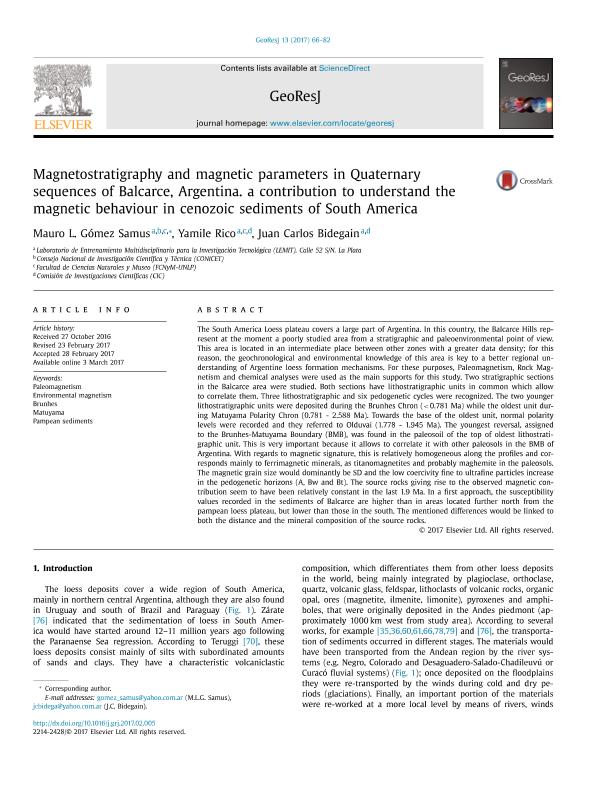Mostrar el registro sencillo del ítem
dc.contributor.author
Gómez Samus, Mauro Leandro

dc.contributor.author
Rico, Yamile

dc.contributor.author
Bidegain, Juan Carlos

dc.date.available
2018-08-22T17:26:44Z
dc.date.issued
2017-06
dc.identifier.citation
Gómez Samus, Mauro Leandro; Rico, Yamile; Bidegain, Juan Carlos; Magnetostratigraphy and magnetic parameters in Quaternary sequences of Balcarce, Argentina. a contribution to understand the magnetic behaviour in cenozoic sediments of South America; Elsevier; GeoResJ; 13; 6-2017; 66-82
dc.identifier.issn
2214-2428
dc.identifier.uri
http://hdl.handle.net/11336/56601
dc.description.abstract
The South America Loess plateau covers a large part of Argentina. In this country, the Balcarce Hills represent at the moment a poorly studied area from a stratigraphic and paleoenvironmental point of view. This area is located in an intermediate place between other zones with a greater data density; for this reason, the geochronological and environmental knowledge of this area is key to a better regional understanding of Argentine loess formation mechanisms. For these purposes, Paleomagnetism, Rock Magnetism and chemical analyses were used as the main supports for this study. Two stratigraphic sections in the Balcarce area were studied. Both sections have lithostratigraphic units in common which allow to correlate them. Three lithostratigraphic and six pedogenetic cycles were recognized. The two younger lithostratigraphic units were deposited during the Brunhes Chron (< 0.781 Ma) while the oldest unit during Matuyama Polarity Chron (0.781 - 2.588 Ma). Towards the base of the oldest unit, normal polarity levels were recorded and they referred to Olduvai (1.778 - 1.945 Ma). The youngest reversal, assigned to the Brunhes-Matuyama Boundary (BMB), was found in the paleosoil of the top of oldest lithostratigraphic unit. This is very important because it allows to correlate it with other paleosols in the BMB of Argentina. With regards to magnetic signature, this is relatively homogeneous along the profiles and corresponds mainly to ferrimagnetic minerals, as titanomagnetites and probably maghemite in the paleosols. The magnetic grain size would dominantly be SD and the low coercivity fine to ultrafine particles increase in the pedogenetic horizons (A, Bw and Bt). The source rocks giving rise to the observed magnetic contribution seem to have been relatively constant in the last 1.9 Ma. In a first approach, the susceptibility values recorded in the sediments of Balcarce are higher than in areas located further north from the pampean loess plateau, but lower than those in the south. The mentioned differences would be linked to both the distance and the mineral composition of the source rocks.
dc.format
application/pdf
dc.language.iso
eng
dc.publisher
Elsevier

dc.rights
info:eu-repo/semantics/openAccess
dc.rights.uri
https://creativecommons.org/licenses/by-nc-sa/2.5/ar/
dc.subject
Brunhes
dc.subject
Environmental Magnetism
dc.subject
Matuyama
dc.subject
Paleomagnetism
dc.subject
Pampean Sediments
dc.subject.classification
Meteorología y Ciencias Atmosféricas

dc.subject.classification
Ciencias de la Tierra y relacionadas con el Medio Ambiente

dc.subject.classification
CIENCIAS NATURALES Y EXACTAS

dc.title
Magnetostratigraphy and magnetic parameters in Quaternary sequences of Balcarce, Argentina. a contribution to understand the magnetic behaviour in cenozoic sediments of South America
dc.type
info:eu-repo/semantics/article
dc.type
info:ar-repo/semantics/artículo
dc.type
info:eu-repo/semantics/publishedVersion
dc.date.updated
2018-08-21T19:11:57Z
dc.journal.volume
13
dc.journal.pagination
66-82
dc.journal.pais
Reino Unido

dc.journal.ciudad
Londres
dc.description.fil
Fil: Gómez Samus, Mauro Leandro. Consejo Nacional de Investigaciones Científicas y Técnicas; Argentina. Laboratorio de Entrenamiento Multidisciplinario para la Investigación Tecnológica; Argentina. Universidad Nacional de La Plata. Facultad de Ciencias Naturales y Museo; Argentina
dc.description.fil
Fil: Rico, Yamile. Laboratorio de Entrenamiento Multidisciplinario para la Investigación Tecnológica; Argentina. Universidad Nacional de La Plata. Facultad de Ciencias Naturales y Museo; Argentina. Provincia de Buenos Aires. Gobernación. Comisión de Investigaciones Científicas; Argentina
dc.description.fil
Fil: Bidegain, Juan Carlos. Laboratorio de Entrenamiento Multidisciplinario para la Investigación Tecnológica; Argentina. Provincia de Buenos Aires. Gobernación. Comisión de Investigaciones Científicas; Argentina
dc.journal.title
GeoResJ
dc.relation.alternativeid
info:eu-repo/semantics/altIdentifier/doi/https://dx.doi.org/10.1016/j.grj.2017.02.005
dc.relation.alternativeid
info:eu-repo/semantics/altIdentifier/url/https://www.sciencedirect.com/science/article/pii/S2214242816300766
Archivos asociados
